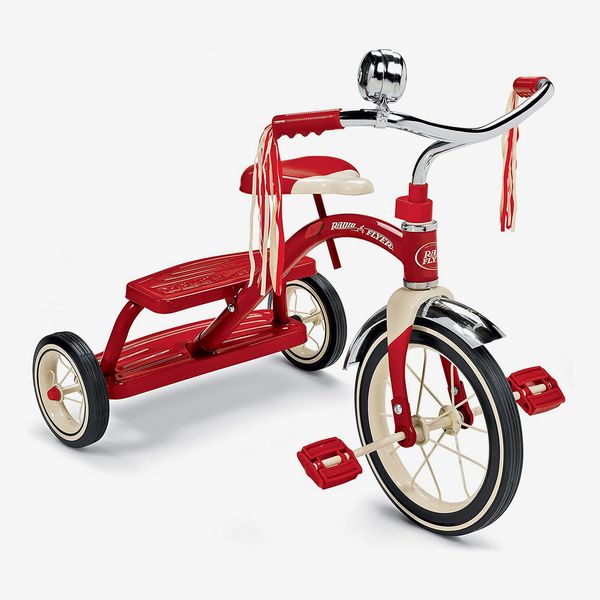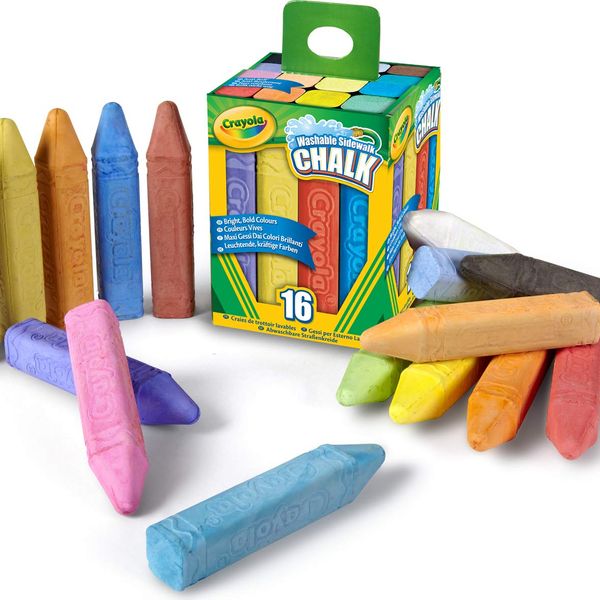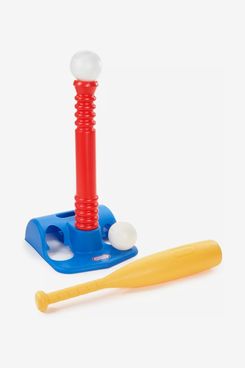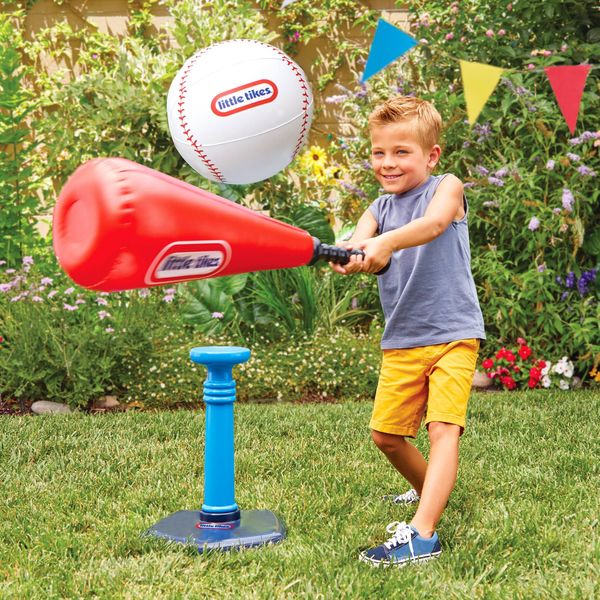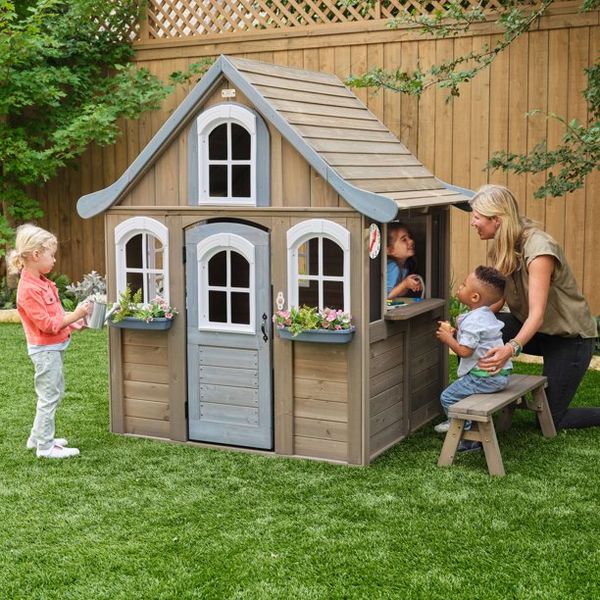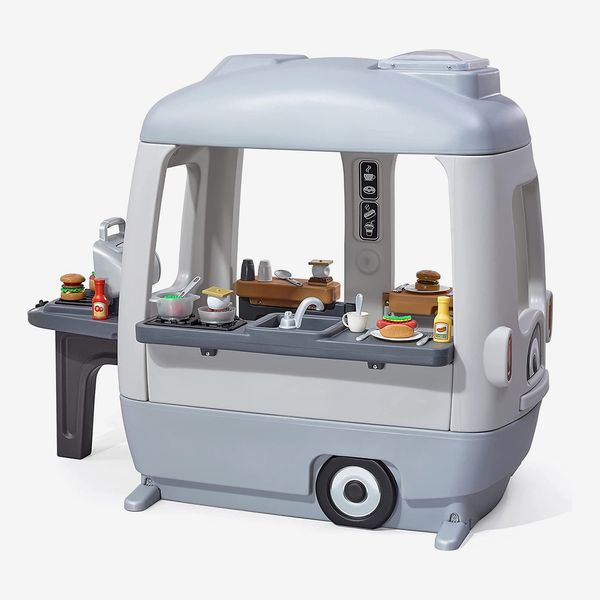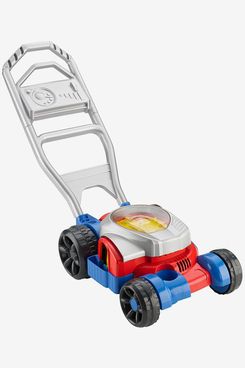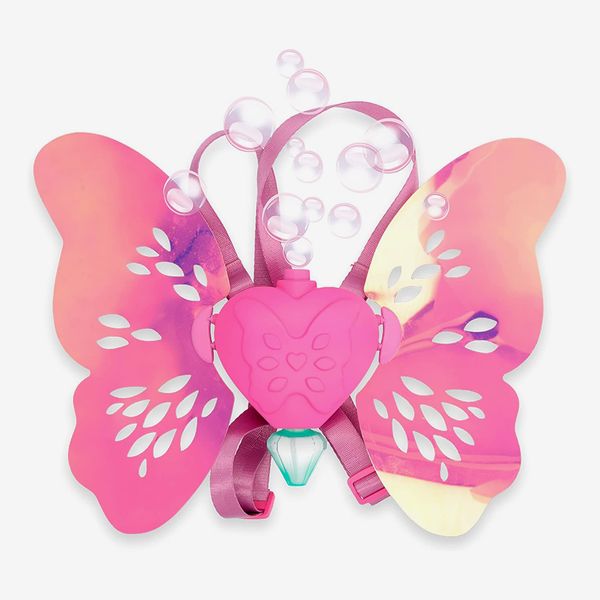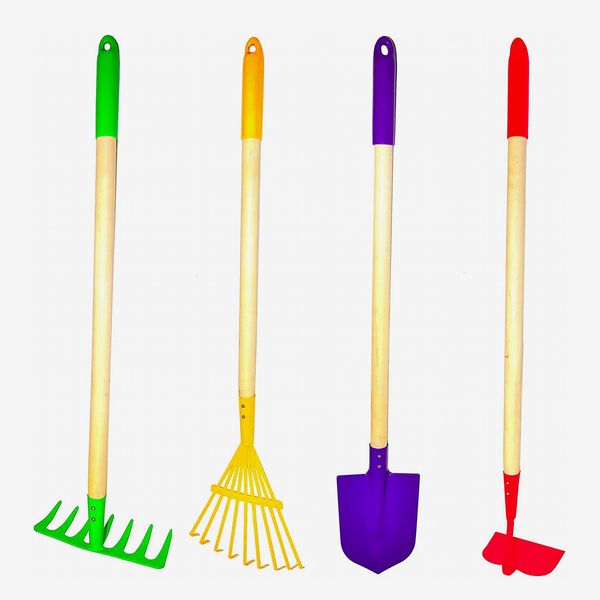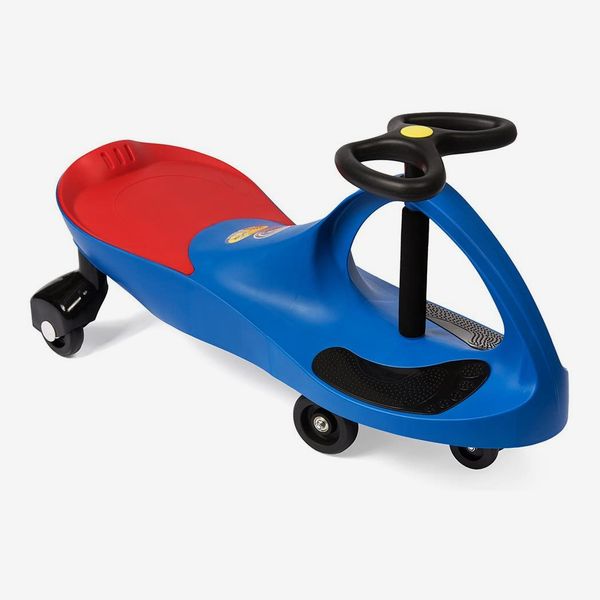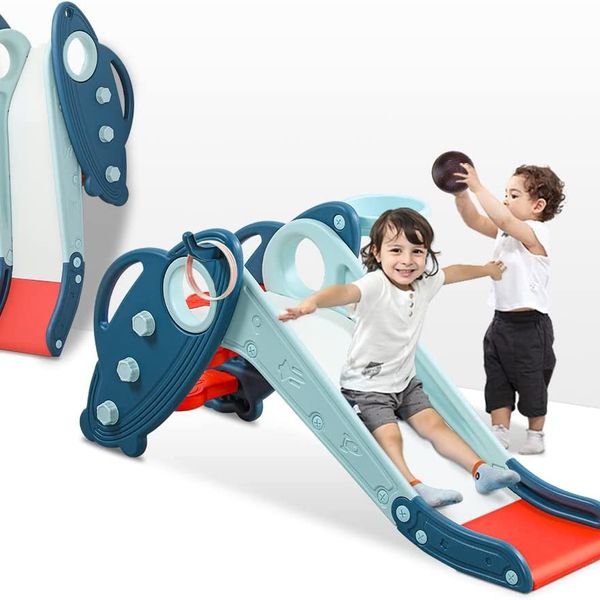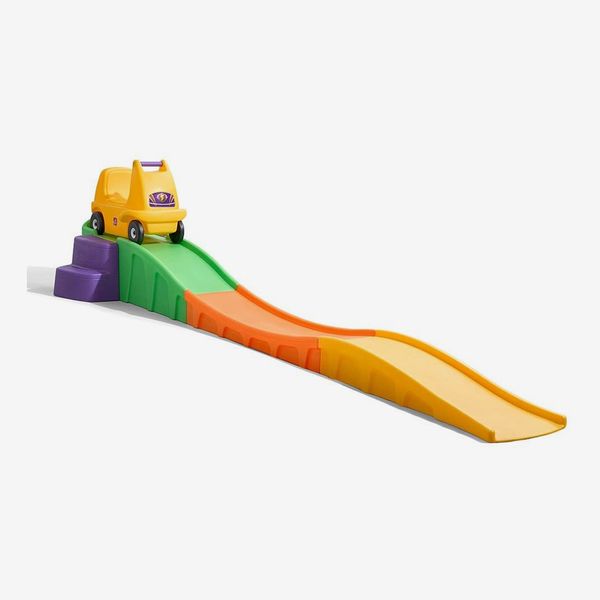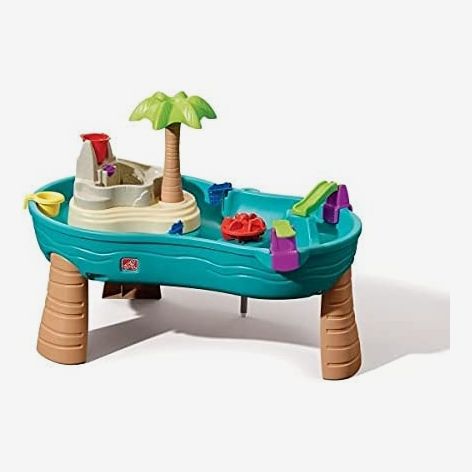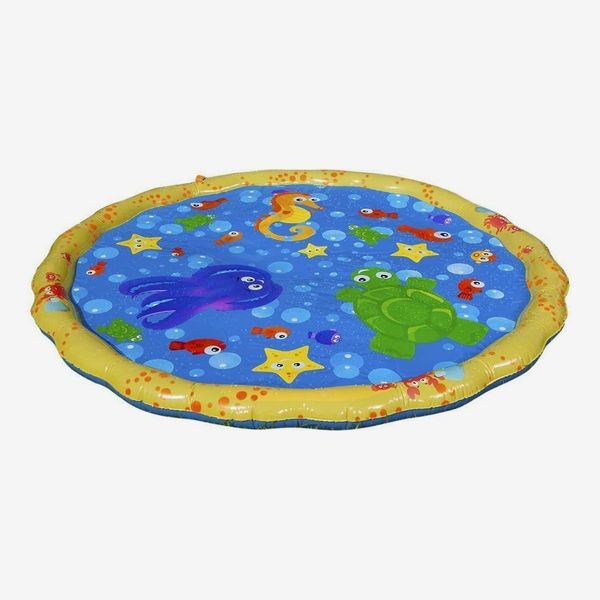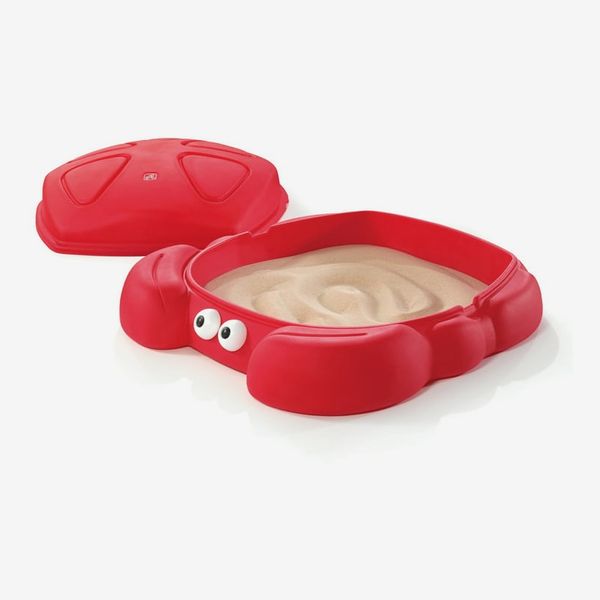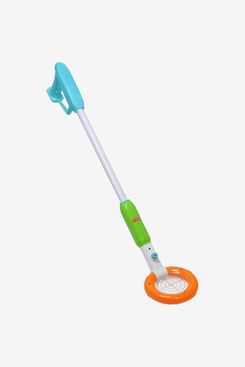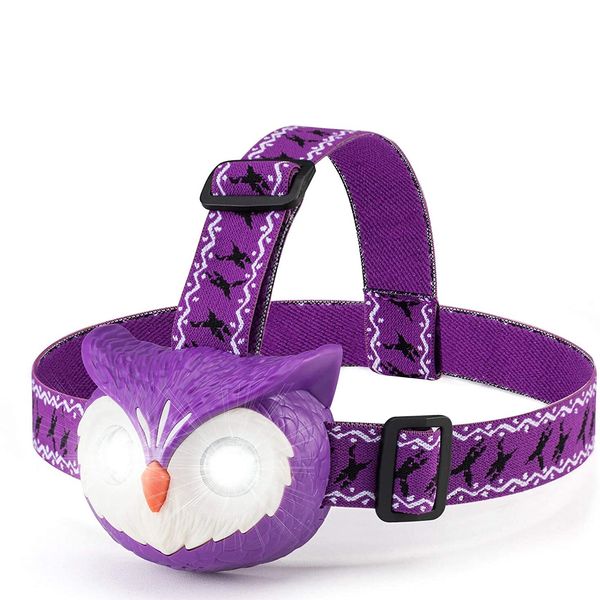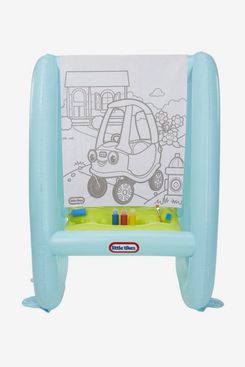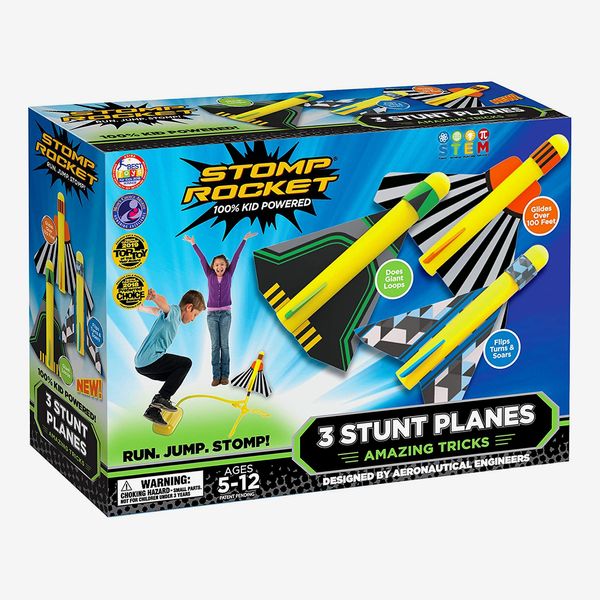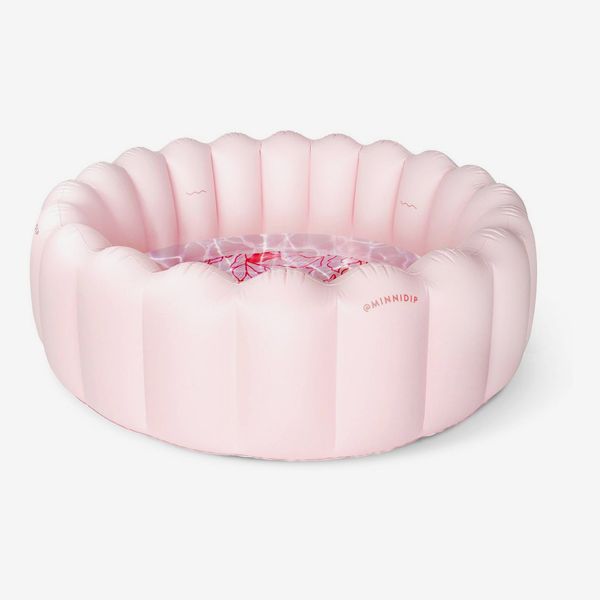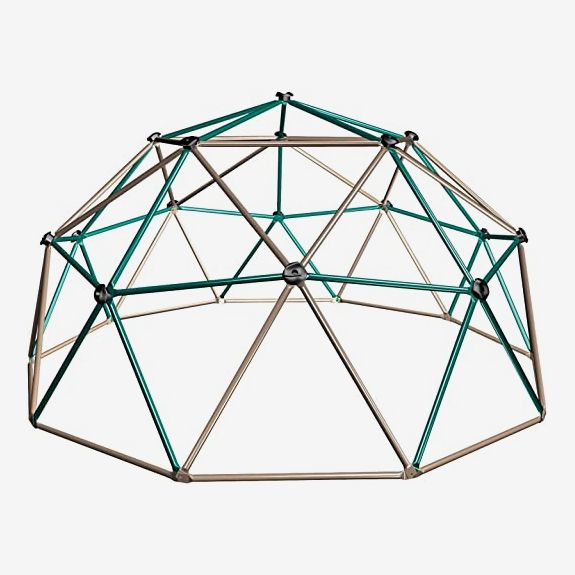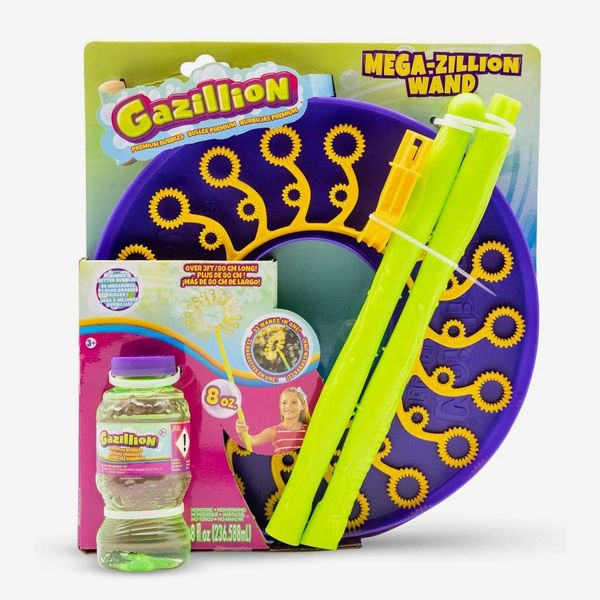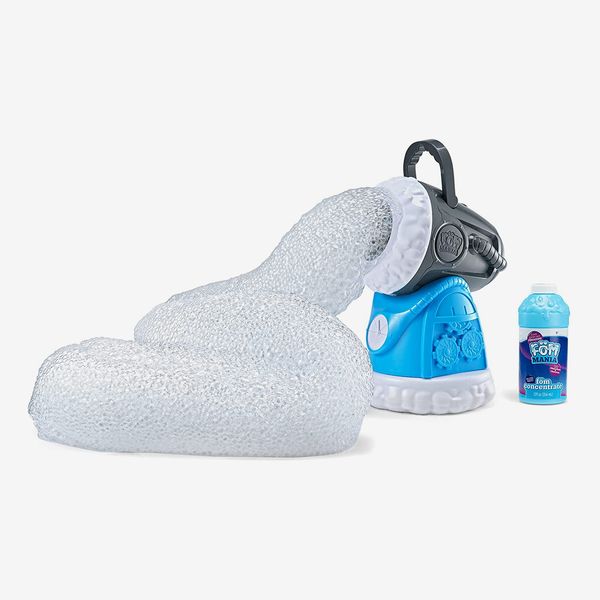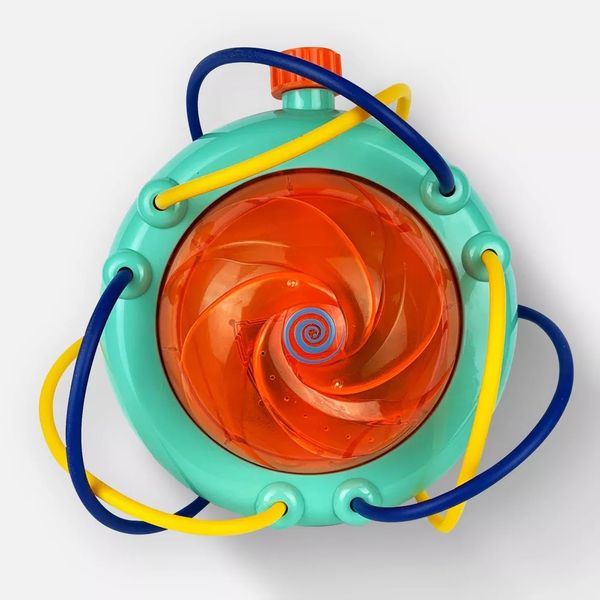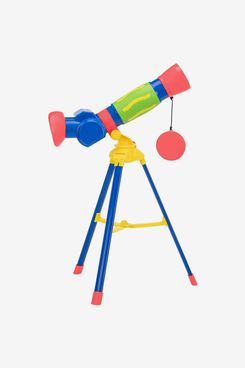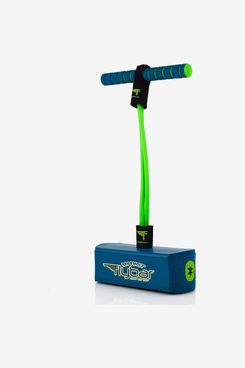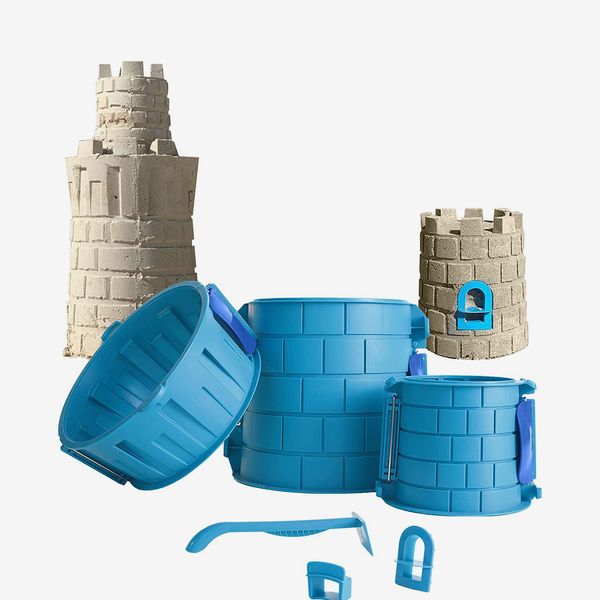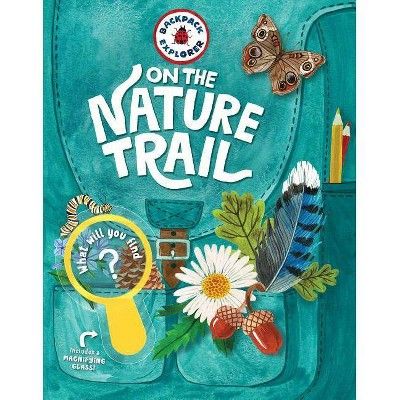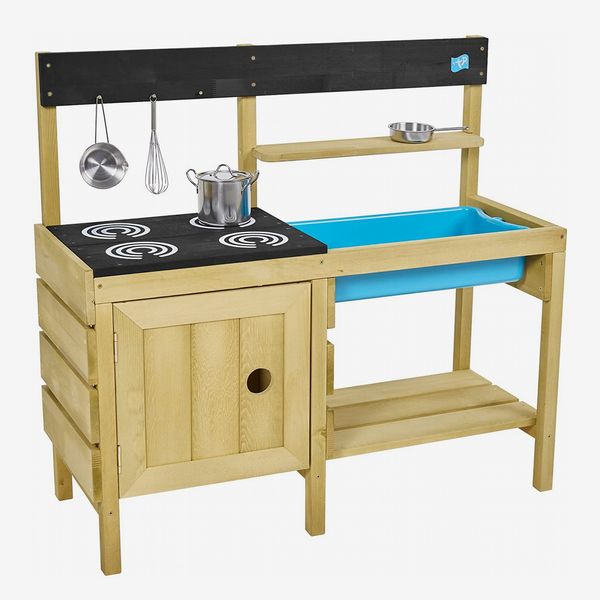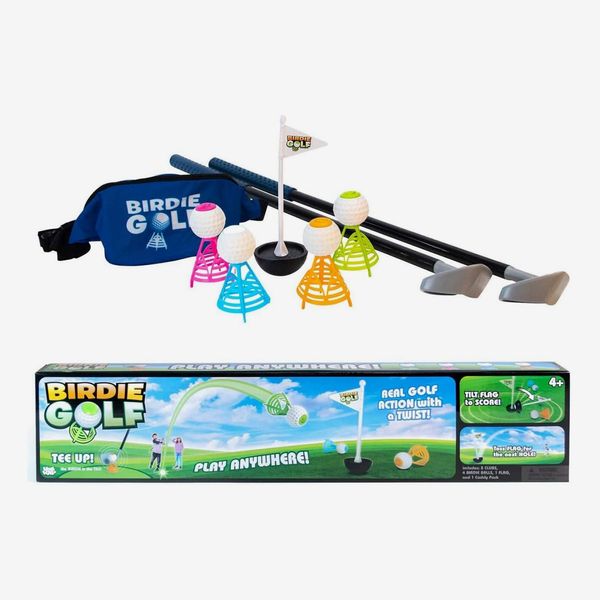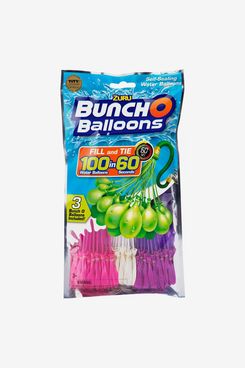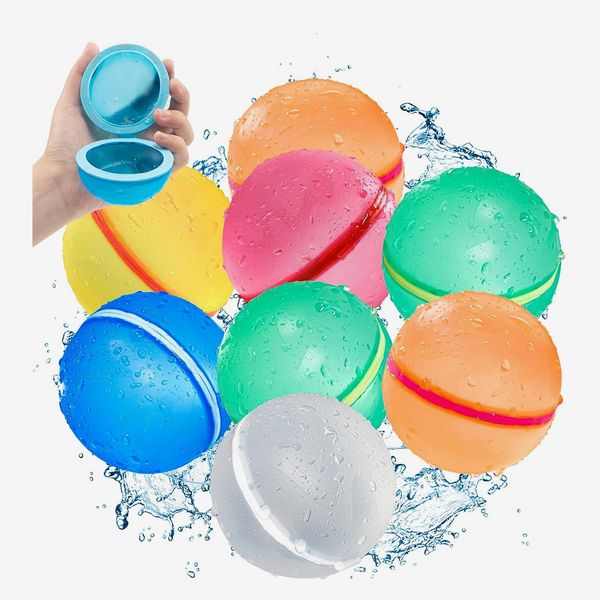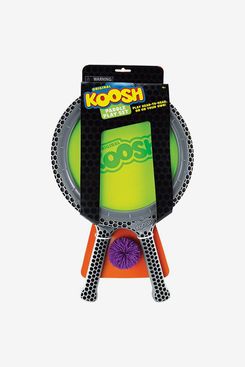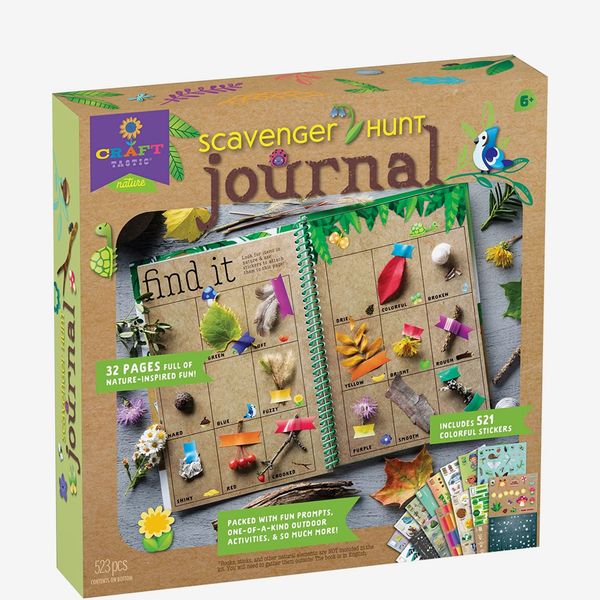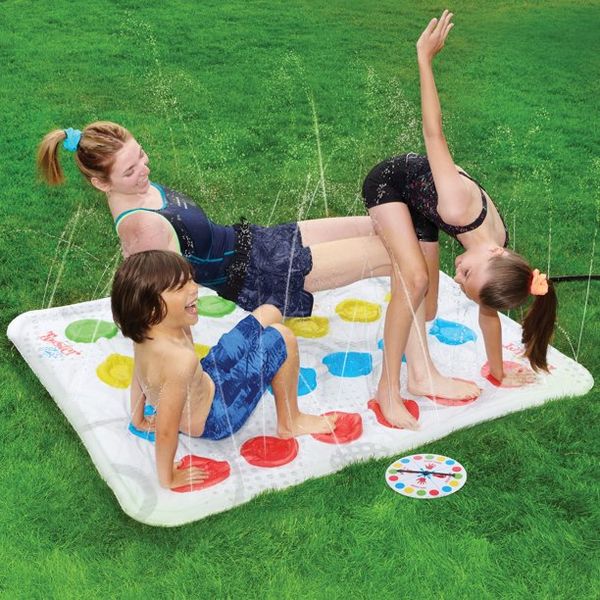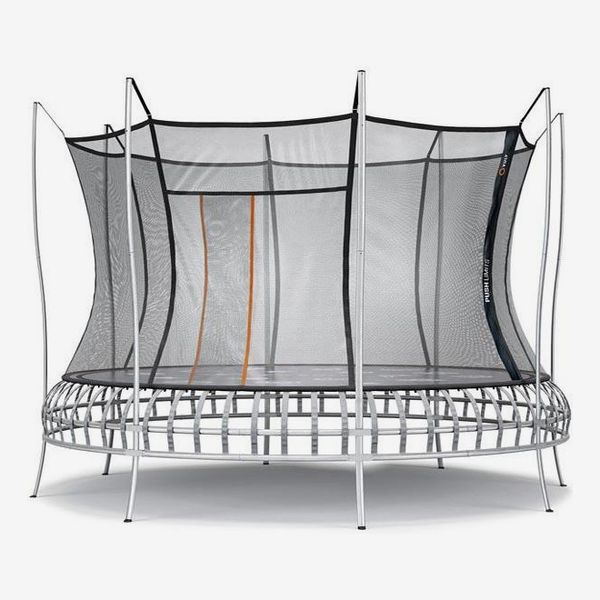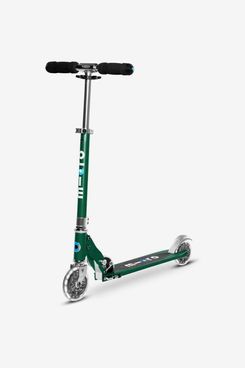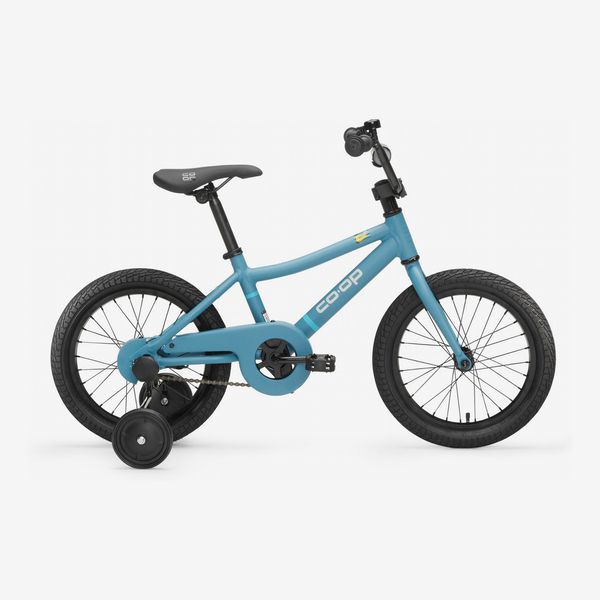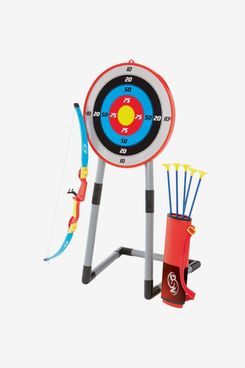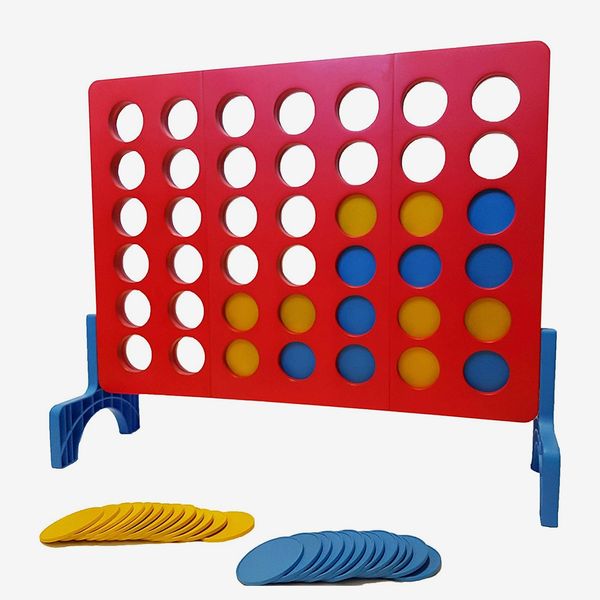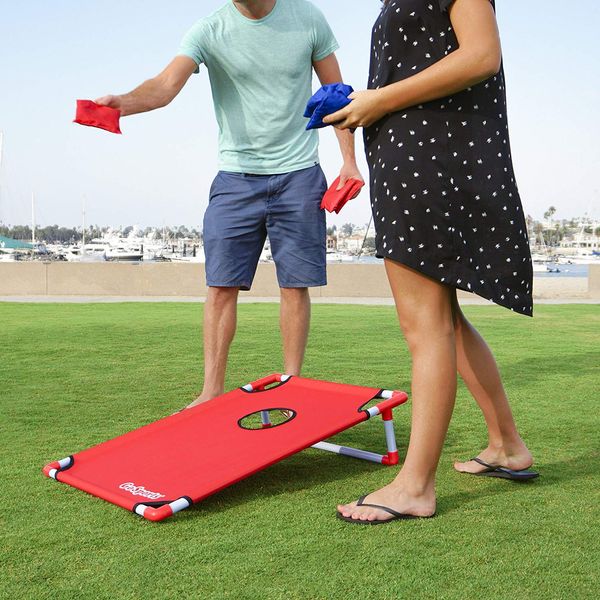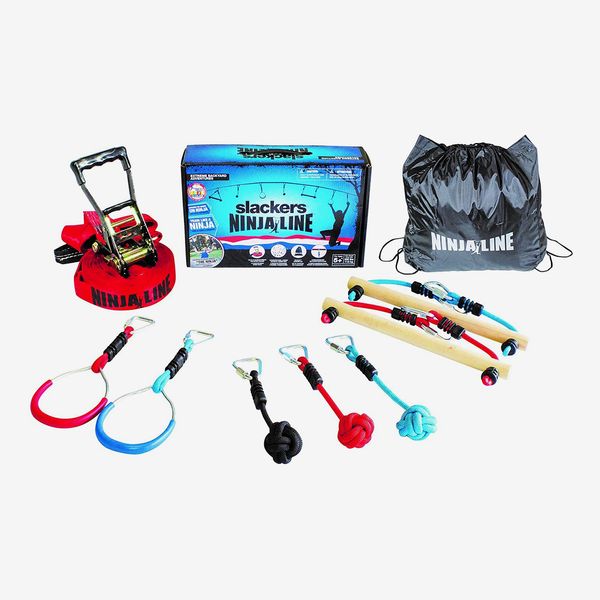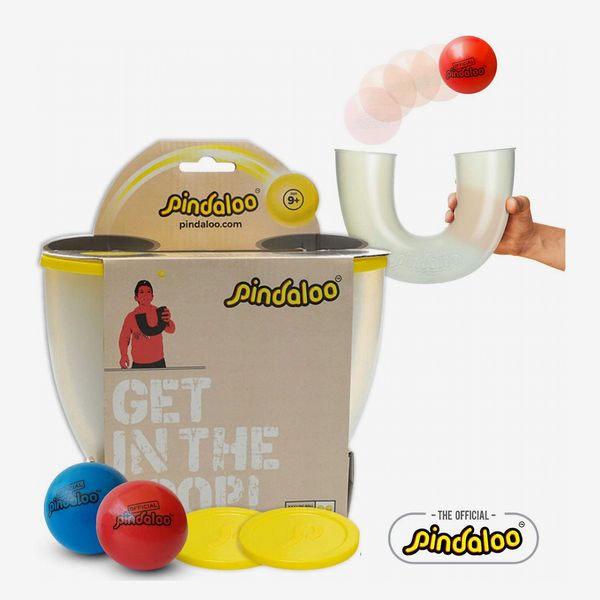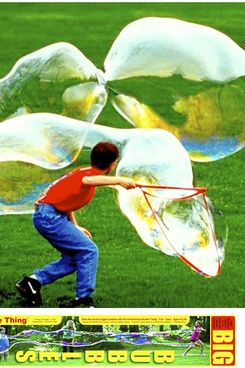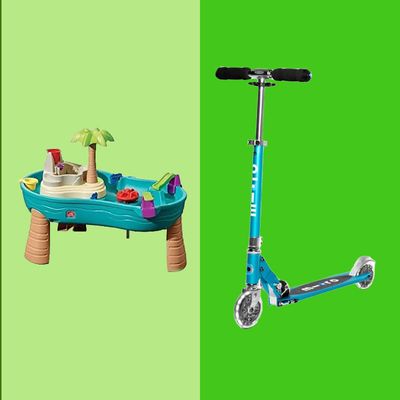
Outdoor toys are fun to play with any time of year, and having an array of balls, water balloons, ride-on toys, and bubble machines can help keep energetic kids busy until sunset. While perennial favorites like kiddie pools and bikes are surefire hits, we set out to add some new outdoor toys to the must-have list. To find them, we gathered suggestions from a slew of experts: child psychologists and toy insiders, children’s librarians and Little Gym owners, kids and parents.
The following list breaks down the most highly recommended outdoor toys by age: 2 through 4, 4 through 6, and 6 through 10. They range from a blow-up art easel to an ATV-style roller coaster, a foam pogo stick to a geometric-dome climber, and a polished aluminum gardening set to suction-cup archery. All the toys are designed to amplify your kiddo’s outdoor fun, but some of them (like this telescope) can be used indoors as well. Many of these products are classics, and several are new within the past few years; some are portable enough for you to take along to the park, and others require your own private outside space. In almost every case, though, they have educational and developmental benefits in addition to letting kids get dirty and run wild.
Best outdoor toys for ages 2 through 4
“I can never overemphasize the appeal of classic outdoor toys like a good, sturdy trike,” says Tracy Camp-Johnston, who is an early childhood educator at Burgundy Farm Country Day School with 25 years of teaching experience. The Radio Flyer trike is stable enough to prevent most tip-overs, yet it still allows kids to get plenty of exercise and to enjoy some feeling of speed and freedom. “They’re a great alternative to an early bike,” adds Dr. Lee Scott, chair of the advisory board for the Goddard School. And from Jim Silver, CEO of toy-review company TTPM: “It’s about a child learning balance and to be comfortable moving themselves. The first time they move on a trike, it’s actually something big to a very young child — having that feeling of movement and learning coordination.”
Sidewalk chalk is a year-round classic activity that can keep the busiest of toddlers entertained (and one that stay-at-home dad Andy Selsberg told us he must keep on hand at all times). The oversize chalk is the perfect size for tiny hands to grasp, and after your kids have sketched out their own Bob Ross–esque masterpiece, you can wash the chalk away with a hose.
As far as sports go for the toddler-to-preschool set, there’s nothing quite like classic T-ball. “Children at these ages love to master new skills, and using a large bat to hit a ball off the tee is a fun challenge for them,” says child psychologist Dr. Nicole Beurkens, noting that it helps develop gross motor skills and hand-eye coordination, as they get gradually accustomed to hitting a ball with the bat — plus it can be played alone or with others. Scott seconds the point about collaboration: “What’s fun is that children can use it to play so well together,” Scott says. “It allows kids to use different sized balls, so both younger and older kids can feel success.”
Little Tikes makes an oversize and inflatable version of its original T-Ball set, which comes recommended by Chris Byrne, a toy expert known as The Toy Guy. He says the Totally Huge set gives little kids who might not have hand-eye coordination down quite yet the chance to feel the satisfaction of a big hit.
If you want to nurture social and emotional development, a playhouse like this wood house with a real ringing doorbell — admittedly not a small investment of money (or assembly time) — “allows siblings of varying ages to engage in parallel play, enjoying the same space while not necessarily doing the exact same activity,” explains children’s librarian Lesley Siegel of the Port Washington Public Library. “When it comes to outdoor play,” adds Silver, “a lot of it is purely physical, but then you have the other level, which is imaginative play.” Kids can set up all sorts of pretend scenarios using the house’s kitchen, café window, chalkboard walls, clock, and phone. (If your little ones have a wide age gap, you can consider the larger, two-level KidKraft Cozy Escape Playhouse, which has everything from a kitchen on the bottom level to a climbing wall and twisty slide for the bigger kids.) And don’t underestimate the freedom kids will find in a space that’s not confined to the walls of their own house: “If there’s dirt in there, that’s fine. If there’s water in there, that’s fine,” says Scott. “Kids get to live their play experience in a more complete way than they can indoors.”
Recommended by Marissa Silva, digital and social content manager at the Toy Insider, this spacious camper combines a classic playhouse, like the KidKraft one above, with a more robust play kitchen and comes with more than 50 accessories — including utensils, a grill, and cookout food like hamburgers, hot dogs, and s’mores. Toddlers can twist the realistic faucet knobs, open and close the swinging door, and listen to the ticking of the stove turning on. The open-ended design encourages kids to use their imaginations, and the layout leaves enough room for cooperative and parallel play with friends or siblings.
The straightforward reason this mower is a tried-and-true hit: “Toddlers and preschoolers love to copy their parent’s activities,” says Beurkens, “which makes ‘mowing’ the lawn with their very own bubble mower an exciting activity for them.” (Even if their parents don’t actually own a lawn mower, they’ve likely seen other adults using them elsewhere.) And there’s a developmental benefit, too: “Besides the fun of watching the bubbles blow around as they push the mower,” notes Beurkens, “kids in this age group are working on valuable gross-motor, balance-, and visual-perceptual skills at the same time.” But to focus on the bubbles feature for a moment: “Never underestimate the power and allure of bubbles, and for kids of all ages,” says Siegel.
This set of wings makes a bubble machine wearable by releasing a consistent stream of bubbles in your child’s wake. “The wings encourage kids to be active and run around — plus bubbles are always a classic,” says Toy Insider senior editor Jackie Cucco. The wings have a switch that turns on the motor, which flutters the wings and pumps out the bubbles.
In addition to emulating the adults in their lives, kids are drawn to gardening because, as Scott puts it, “they like getting dirty.” This garden-tool set stands out for how genuinely functional — and durable — the pieces are, as Strategist contributor Steven John can attest after years of owning some that still remain in great shape. The handles are made of solid wood, the heads of Technicolor metal. The handles’ tops are coated in a rubber that makes them even better suited for no-slip gripping (each rubber covering has a hook that allows for equally easy hanging on the wall). Says Siegel: “They can rake, hoe, and dig,” and it has the potential to become all the more exciting because “maybe they’ll find a worm or some beetles while digging.”
“These are ride-on toys that kids propel using their arms by wiggling the steering wheel,” explains Debbie Imperator, manager and toy buyer of Funky Monkey Toys & Books in Greenvale, New York. Perfect for the 2- to 4-year-old range, and, notes Imperator, “they can actually support up to 220 pounds, so parents can take them for a spin.” The self-moving element is important developmentally, according to Scott, and it makes it much harder to lose control and risk accident and injury, which can happen with ride-on toys that start rolling out of control. The PlasmaCar is less about speed than it is about enjoying twists and turns and motion in general, so they’re ideal for cul-de-sacs, large driveways, or spacious patios.
For a toddler, a simple slide can provide hours of fun. This freestanding three-in-one version has a basketball hoop on one side and a ring toss on the other. With so many ways to play, Playgarden co-founder and COO Amanda Vierheller says that it “encourages whole-child development and extends playtime,” as toddlers use gross motor skills to climb the stairs and slide down and work on hand-eye coordination while shooting hoops or playing ring toss. If you have the space, it can be used inside as well — and when playtime is over, it folds up for easy storage.
An at-home amusement-park experience: “For a younger child, these are just pure excitement, and they’re really pretty safe,” says Silver. “For the young kid who likes the idea of going fast, going up and down — this is a great way to get acclimated to going a little fast and being high up.” Which is very true to the experience of Annie Young, mother of two, former 15-year New York City educator, and owner of the Little Gym of Roslyn in Roslyn, New York, where she has become something of an expert on kids who love action: “I knew this toy was going to be a hit with my toddler the minute I saw it,” she says. “It provides nonstop excitement.” And for PAW Patrol fans, there is now a licensed version of the toy that features Chase’s police cruiser as the vehicle. As a bonus, these sets are suitable for indoor use if you have a room with at least 20 or so feet of clearance.
With enough space for your toddler to play solo or with a couple of friends, occupational therapist, blogger, and toy expert Keri Wilmot says that this water table “encourages sensory play” and provides plenty of opportunities for pretend play. The set comes with nine accessories, including two swimmer figures, and has a drainage hole to make emptying the water easier.
At the height of pandemic-induced supply-chain issues, Strategist writer and mom of two Lauren Ro couldn’t get her hands on a kiddie pool, so she ordered a splash pad like this one. She calls it “a fresh reprieve on a hot summer day” that is less stressful than packing a beach bag. All you have to do is connect it to a regular garden hose and start splashing.
It may be obvious, but kids thrive in the sandbox — “a place where they get to create fun and adventure with the natural resources around them,” says Mike Conners, a junior kindergarten teacher from Burgundy day school. The Step2 version, with its pleasingly familiar design and easy-to-secure cover, has been a high-quality favorite among parents for ages — and when it comes to an investment that’s going to get as much use as a sandbox, this is a case where you’ll want to go with one that has all of the bells and whistles. More on why sand play is particularly wonderful: “The textures, learning to pour, learning to build, learning to measure … We have to encourage kids to do more sensory-motor play like this because our children are just stuck to keyboards and screens,” says Scott.
This toy actually detects metal, lighting up and beeping when, say, a penny is sensed in the sandbox. Laurie Schacht, chief toy officer with the Toy Insider loves how it “encourages parents and children to spend time together on the hunt for treasures.” While a functional tool, this metal detector was 100 percent designed with kids in mind. It is small and lightweight enough for little bodies to handle for hours on end, and affordable enough to where parents won’t mind if it’s dropped a time or ten during archaeological outings. On rainy or cold days, when you can’t bury objects on the beach or in the woodchips at the park, John recommends covering them with a sheet and playing anywhere you have room in the house.
Dr. Alexandra Figueras-Daniel, the associate director of Bank Street College of Education’s Straus Center for Young Children & Families, reminds us that the best outdoor toys help kids “observe nature and build science concepts that get so overlooked inside.” Some aspects of nature and science can really only be observed come nightfall, which is where this cute headlamp comes in. Figueras-Daniel told us that her own kids use it on walks or while playing outside at night with their friends. “We have gone on night hikes, and the headlamps offer a way to keep your hands free for exploring,” she adds, noting that even having a kid wear it for a short evening stroll around the neighborhood is a “fun way to see what nature you might get a glimpse of.”
Your mini-Picasso can take their creativity outdoors with this inflatable. Recommended by both Wilmot and Cucco, the easel comes with three tubes of washable paint, three applicators, and ground stakes to keep it securely in place. “Cleanup is really easy because you can just hose it down,” Cucco says.
For ages 4 through 6
You probably know how Stomp Rockets work, but in case not, children’s librarian Siegel offers this straightforward explainer: “Kids literally stomp to make the rockets go, then run after the rockets once they’ve been launched.” Or, as Silver puts it, “How hard can you stomp? How high can you make it go? It’s as simple as that.” The fun is in the competition, and the way it brings kids together: “Any child really any age can do it,” says Silver. “A bigger kid, or even an adult, can send it soaring.” Plus, in this version, there are three different kinds of planes (looper, glider, wildcat) that perform varying tricks in the air, as designed by aeronautical engineers.
Nothing says summertime like hopping into a slightly too-cold pool — extra points if it isn’t an eyesore, like this stylish one with scalloped edges from Minnidip. Just under five feet in diameter, the pool is big enough for a solo dip in the backyard. The easy-to-inflate valve is compatible with a standard pump or even a hair dryer (be sure to use it on a cool setting to avoid melting the plastic).
This powder-coated steel dome encourages the kind of rough-and-tumble action that lots of kids don’t get enough of these days. Which is why Beurkens says she loves the idea of them scaling and experimenting on it: “We are so panicked about children climbing and running, and they need to be able to take risks. They need to fall down every now and then and bump their little knees.” It’s a favorite of Young’s: “Kids love climbing it, hanging upside down, swinging, and making it into their secret clubhouse,” she says. They’re building strength, balance, self-confidence — and can throw a tarp or large blanket over it to create the perfect fort for evening ghost stories.
Byrne says the brand Gazillion makes the very best bubble fluid out there. He recommends the Mega Zillion Wand, which has 33 mini wands built into the paddle so you can get the most out of each dip.
Another Byrne recommendation is this foam machine with the main draw that it makes bonkers amounts of foam. Byrne says you can pick up the foam and throw it, cover the backyard with it, or use it to create a fun sensory experience.
If you want to skip the kiddie pool but still enjoy sunny days splashing around, this wiggling sprinkler always gets the job done for my son and his younger cousins. The sprinkler arms wiggle around, spraying a pretty significant amount of water. The hose hookup is a breeze and doesn’t leak. And it has already held up through an entire summer of roughhousing, so we’ll be breaking it out this year as soon as “tank top and shorts” weather arrives.
Schacht recommends this focus-free, 10-times-magnification telescope because “the best toys are those with an educational component that are so much fun, kids never know they are learning.” Little ones can peer through the two jumbo eyepieces and see the moon — or use it to nature-watch by day, as it’s perfectly suited to use before sunset, too. (It should be said that it is unfortunately not powerful enough to zoom in on the stars, but still a great value for how well it works in other ways.) Among other useful features, like an adjustable tripod, it comes with a guide that depicts the lunar phases.
By age 4, according to Beurkens, kids have mastered the gross-motor and balance skills needed to go nuts on this modified pogo stick, which has a foam base and handles for added comfort and security. “The jumper’s sturdy base allows them to have more success than with a regular pogo stick,” Beurkens says. “They can set up races, create paths to navigate around, or jump to the mailbox.” Silver is a fan of the young-kid-friendly design: “A lot of kids even 5 or 6 years old don’t have the balance to be on a traditional pogo stick,” he says, but the wider base here “encourages the kids to have success, to continue, to get active.” This is another toy that can be used indoors, provided you have the space.
You know those springform pans bakers use to make cheesecake? This is basically that, but for building sand castles. Byrne likes that it is made by a little company out of Connecticut and helps kids learn about engineering while having a very satisfying play experience.
This field guide, which comes with a pull-out magnifying glass in addition to the many seek-and-find lists for all manner of worms, birds, and flowers, is a vehicle for endless outdoor entertainment. Paige Hirsch, chief content editor of Plinkit and former elementary-school teacher, believes it really helps kids “meaningfully engage with the natural world.” And, she reminds us, “research shows that children who spend time in nature are healthier, more focused, have happier emotional lives, are more resistant to stress, and aware of their senses.”
“A young child’s homework should always include sticks, rocks, and mud,” says Camp-Johnston. Which brings us to all the mud pies you can make with this outdoor play kitchen. The sink holds up to nine quarts of water or two gallons of mud among the spacious surroundings, which include roomy shelving and a set of stainless-steel pans. Adds Beurkens: “Playing with mud kitchens teaches so many skills. You talk about science, experimenting, even spatial awareness — what fits in what when I pour it in here, or try to mix this with that.” In other words, this toy functions as a science lab and art studio, too. (And if a specialized mud kitchen like this one isn’t in your budget, Facebook Marketplace is a great source to score well-loved play kitchens for cheap — look for an all-plastic model that will stand up to the elements and let your kid go wild.)
Children are usually old enough for formal golf instruction at age 6, but kids several years younger than that often love less rigorous involvement with the sport, and it’s surprising just how well the game can hold their attention span. The challenge for parents, though, is finding a way to get them on a golf course when they won’t be intrusive to the adult players. Which is why Schacht highly recommends this portable Birdie Golf set: You can set up a golf course anywhere you go, with weighted flags that stand in for holes (rather than sinking the ball in the hole, your aim is to knock over the flag), badminton-style birdies that function as both ball and tee, two putters, and even a fanny pack for carrying the game around wherever you should decide to play it. The kids get “real golf action just about anywhere,” says Schacht, as it works on the beach or in the basement on a rainy day.
For ages 6 through 10
“They’re just a bunch of balloons,” says Silver. But that simplicity seems to be the reason three of our experts (including John) have such high praise for them. You simply attach the balloon bunch to a hose, turn it on, and fill dozens of water balloons in a few seconds. They even self-seal once full, saving parents time and keeping the kids in motion (and playing independently). Also noteworthy: The small balloons are the perfect size for younger kids’ hands, and because they’re soft-sided, they won’t cause injury even with the occasional head-shot. And, of course, they’re a great way for kids to stay cool on a hot day.
These TikTok-viral reusable water balloons can be filled, sealed, and played with repeatedly. Made of tear-resistant silicone, the spheres simply pop open for kids to scoop up water and seal shut using a tiny, enclosed magnet. Since they are reusable and easy enough for older kids to fill up independently, you can squeeze years of play out of a single set.
This set comes with everything your child and a friend need to start a paddleball game of their own creation. Even though it comes with sample rules for games with either one or two players, the open-ended nature is what makes it especially fun — I play with it with my 10-year-old, and I usually let him make up whatever rules he wants, since there really isn’t a wrong way to play.
If you know a child who is endlessly intrigued by earthworms and colorful rocks, Silva recommends this journal full of nature-related prompts that “challenge kids to find different things outside like leaves and bird feathers.” Once they’re done scavenging through the backyard, the journal comes with more than 500 stickers to attach their new treasures and record their findings.
Kids have been playing Twister for generations, and Cucco says this “new take on a classic retro game” is one that the whole family can enjoy. Simply twist your garden hose onto the Twister mat (which takes about one minute to fill), and once the water starts squirting out, play the game according to the traditional rules. First person to let their elbow, knee, or bum hit the mat, they’re out!
“Trampolines are showing up in more and more backyards — high-end trampolines,” says Silver. That’s because, he says, we’ve made great strides in the safety of them — case in point this Vuly Thunder model, which is “all netted in” with “foam pads everywhere.” As far as home trampolines go, this one is the largest and therefore priced on the higher end of the spectrum, ranging from roughly $500 to nearly $2,000, depending on size. It’s certainly an investment, but if you’re concerned about the quality (the coils, the hooks, the tapered ends, the mesh enclosure) — and with a trampoline, you should be — “Vuly is the brand I’d be looking at,” Silver affirms. The dimensions of this extra-large model are about 14 feet in diameter, but with two adults working together, assembly should take under two hours. And this thing is built to withstand UV rays and severe weather alike. It can be a great workout option for parents.
We hear about the Micro Kickboard all the time — from toy-store owners, parents, and kids — and we’re probably not going to stop hearing about it anytime soon. “These are one of the best scooters on the market, and really one of the best-selling toys around,” says Imperator, who attributes their popularity to their exceptional stability, how easy they are for kids to turn and control, and how seamless they are for parents to assemble. Dr. Nicholas Kardaras, a psychologist and the author of Glow Kids: How Screen Addiction Is Hijacking Our Kids — and How to Break the Trance, is strongly in favor of scooters, in general, because they’re “something that can naturally raise a child’s dopamine levels” — as opposed to the dopamine rush of video games. They give kids a sense of freedom, and, because this more-challenging two-wheel model has adjustable handlebars and a 220-pound weight limit, it can grow with them from age 6 to well into their teens. At that point, adds Imperator, “there’s a similar one for adults.”
Two of the experts we interviewed for our Best Bikes for Kids article — Natalie Martins, the owner of the kids’-bike review site Two Wheeling Tots, and Kristen Bonkoski, the founder of the popular kids’-bike website Rascal Rides — recommend this REI option because of its affordable price, light aluminum frame, and the company’s amazing return policy.
This archery set with suction cups is a fun and safe way for kids “to work on mental focus, eye-hand coordination, and spatial awareness,” says Beurkens. “Kids will be motivated to hone their aim and to see how far they can move from the target to still hit their goal.” The fact that archery can be as satisfying for solo play as well as collaborative competition means it can help foster both independence and social skills.
This jumbo-size version of the classic game Connect Four stands about two feet tall and is sure to be a crowd-pleaser. The concept is simple enough for younger kids to grasp while still fun and challenging for older age groups able to think a few moves ahead — adults included. Plus it “promotes gross motor development while simultaneously growing cognitive skills” like matching, patterns, and strategy, says Vierheller.
According to Silver, Cornhole, which is usually played in groups of at least two, has “replaced horseshoes as the go-to lawn game.” Silver thinks its popularity is largely due to the televised presence of the game, and perhaps it’s in part a matter of convenience: No one wants to order heavy metal horseshoes on Amazon, but if you get a lightweight portable set like this one, cornhole is a lot easier to ship to your home. Each target pops right open, and just as quickly collapses back into the carrying case, along with the beanbags, for a combined weight of just about ten pounds. Young recommends the set and has this bonus tip: “Teach your school-age child the proper scoring rules for adding in some math practice.”
Upon looking at this obstacle course — with nylon ropes, gymnastics rings, monkey-bar holds — “you might think of skills like strength and coordination,” says Plinkit’s Hirsch. “But we look at it and think about cognitive skills like persistence and resilience.” Parents can design and redesign the course in all kinds of ways, including those that are best suited to their kids’ age and ability (it’s recommended for children as young as 6), but then again, the fact that they likely won’t be able to master it at first is part of the point: “The NinjaLine is a great way of teaching simple life lessons like falling and getting back up,” says Hirsch. “Redesign it and provide new opportunities for cognitive flexibility.” The maximum weight rating for the Slackers NinjaLine is 250 pounds, so adults can get involved too.
This part-juggling, part-catch game “encourages kids to move their hands and brains in a unique way,” says Hirsch. “It engages both sides of the brain to develop bilateral and hand-eye coordination and visual-spatial planning.” The kit starts with a ball tossed in the air, then caught and sent looping back into the air time and again; the funky-looking set can be used anywhere, from the beach to the pool to the porch. “When you see it,” Hirsch adds, “you immediately want to try it.”
Little kids aren’t the only ones who love bubbles. Bigger kids tend to, too, but typically get more excited by … well, bigger bubbles. That’s why Beurkens suggests this kit — which can produce what she calls “the world’s largest” bubbles — for older kids who loved blowing smaller bubbles when they were younger. “Older children love the challenge of mixing up the solution and mastering the art of using the wand to create the biggest bubble possible,” she explains. The bubbles can stretch out to a dozen feet or more, and you can whip up literal gallons of solution with the included concentrate. Additionally recommended by Siegel and Beurkens, the kit “helps kids this age work on important skills, such as following instructions, perseverance, and eye-hand coordination,” Beurkens says.
Additional reporting by Liza Corsillo, Lauren Ro, and Steven John
The Strategist is designed to surface the most useful, expert recommendations for things to buy across the vast e-commerce landscape. Some of our latest conquests include the best acne treatments, rolling luggage, pillows for side sleepers, natural anxiety remedies, and bath towels. We update links when possible, but note that deals can expire and all prices are subject to change.

